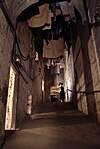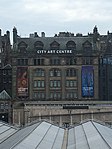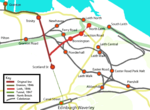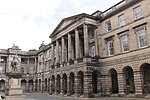St Giles' Cathedral (Scottish Gaelic: Cathair-eaglais Naomh Giles), or the High Kirk of Edinburgh, is a parish church of the Church of Scotland in the Old Town of Edinburgh. The current building was begun in the 14th century and extended until the early 16th century; significant alterations were undertaken in the 19th and 20th centuries, including the addition of the Thistle Chapel. St Giles' is closely associated with many events and figures in Scottish history, including John Knox, who served as the church's minister after the Scottish Reformation.Likely founded in the 12th century and dedicated to Saint Giles, the church was elevated to collegiate status by Pope Paul II in 1467. In 1559, the church became Protestant with John Knox, the foremost figure of the Scottish Reformation, as its minister. After the Reformation, St Giles' was internally partitioned to serve multiple congregations as well as secular purposes, such as a prison and as a meeting place for the Parliament of Scotland. In 1633, Charles I made St Giles' the cathedral of the newly created Diocese of Edinburgh. Charles' attempt to impose a Scottish Prayer Book in St Giles' on 23 July 1637 caused a riot, which precipitated the formation of the Covenanters and the beginnings of the Wars of the Three Kingdoms. The church's role in the Scottish Reformation and the Covenanters' Rebellion has led to its being called "the Mother Church of World Presbyterianism".St Giles' is one of Scotland's most important medieval parish church buildings. The first church of St Giles' was a small, Romanesque building of which only fragments remain. In the 14th century, this was replaced by the current building, which was enlarged between the late 14th and early 16th centuries. The church was altered between 1829 and 1833 by William Burn and restored between 1872 and 1883 by William Hay with the support of William Chambers. Chambers hoped to make St Giles' a "Westminster Abbey for Scotland" by enriching the church and adding memorials to notable Scots. Between 1909 and 1911, the Thistle Chapel, designed by Robert Lorimer, was added to the church.Since the medieval period, St Giles' has been the site of nationally important events and services; the services of the Order of the Thistle take place here. Alongside housing an active congregation, the church is one of Scotland's most popular visitor sites: it attracted over a million visitors in 2018.











